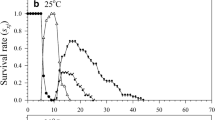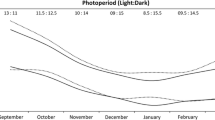Abstract
The Russian wheat aphid (RWA),Diuraphis noxia (Mordvilko), exists with holocyclic life cycle in Tacheng, Xinjiang in Northwest China. It produces males and oviparae to mate and oviposit for overwintering by eggs. Under laboratory conditions with 14 h/d photophase and temperature not lower than 15°C, RWA occurred in parthenogenesis and produced no males. The laboratory populations of Russian wheat aphid, which were kept under natural conditions in fall by 15th, 49th and 81st generation while wild populations produced males and oviparae for mating, produced males and oviparae with their number decreased gradually, but viviparae and nymphs increased sequentially. As a result, it produced a small amount of oviparae and no males emerged in fields by 49 generations’ reproduction in laboratory. After development of 81 generations, oviparae happened occasionally and no eggs occurred for overwintering instead of viviparae and nymphs. A hypothesis of RWA disastrous process was proposed. The life cycle of RWA can be changed from holocycly to anholocycly in its long-term spread and evolution. Anholocycly is more dangerous than holocycly to small grains for its strong adaptability and dispersal ability.
Similar content being viewed by others
References
Moran, N. A., The evolution of aphid life cycles, Annual Review of Entomology, 1992, 37: 321.
Grossheim, N. A., The barley aphidBrachycolus noxius Mordvilko, Memoirs of Natural History Museum of the Zemstvo of the Government of Taurida, 1914, 3: 35.
Zhang, R., Zhang, G., Russian wheat aphid,Diuraphis noxia, and its research progress in China, in Proceedings of the National Symposium on IPM in China (ed. Zhang, Z. L.) (in Chinese), Beijing: China Agri. S&T Publishing House, 1996, 435–439.
Kiriac, I., Gruber, F., Poprawski, T. et al., Occurrence of sexual morphs of Russian wheat aphid,Diuraphis noxia (Homoptera: Aphididae) in several locations in the Soviet Union and Northwestern United States, Proceedings of Entomological Society of Washington, 1990, 92(3): 544.
Halbert, S. E., Stoetzel, M. B., Historical overview of the Russian wheat aphid (Homoptera: Aphididae), in Thomas Say Publications in Entomology: Proceedings, Responds Model for an Introduced Pest —The Russian Wheat Aphid (eds. Quisenberry, S. S., Peairs, F. B.), Maryland: Entomological Society of America, 1998, 13–30.
Basky, Z., Jordaan, J., Comparison of the development and fecundity of Russian wheat aphid (Homoptera: Aphididae) in South Africa and Hungary, Journal of Economic Entomology, 1997, 90(2): 623.
Stoetzel, M. B., Hammon, R. W., Now collections of sexuales of Diuraphis (Homoptera: Aphididae) in North America, Proceedings of Entomological Society of Washington, 1992, 94(3): 598.
Hewitt, P. H., van Niekerk, G. J. J., Walters, M. C. et al., Aspects of ecology of the Russian wheat aphid,Diuraphis noxia, in the Bloemfontein district (I)-The colonization and infestation of sown wheat, identification of summer hosts and cause of infestation symptoms, in Progress in Russian wheat aphid (Diuraphis noxia Mordvilko) research in the Republic of South Africa (ed. Walters, M. C.), Portoria: Perskor for the Government Printer, 1984, 3–13.
Butts, R. A., Cold hardiness and its relationship to overwintering of the Russian wheat aphid (Homoptera: Aphididae) in South Alberta, Journal of Economic Entomology, 1992, 85(3): 1140.
Burd, J. D., Butts, R. A., Elliott, N. C. et al., Seasonal development, overwintering biology, and host plant interactions of Russian wheat aphid (Homoptera: Aphididae) in North America, in Thomas Say Publications in Entomology: Proceedings, Responds Model for an Introduced Pest —The Russian Wheat Aphid (eds. Quisenberry, S. S., Peairs, F. B.), Maryland: Entomological Society of America, 1998, 65–99.
Mordvilko, A., On the evolution of aphids, Archiv für Naturgeschichte (Leipzig New Series), 1934, 3: 1.
Zhang, G., Zhong, T., Life cycles of some aphids, in Sinozoologia (ed. Institute of Zoology, Chinese Academy of Sciences) (in Chinese), 1982, 2: 7.
Kovalev, O. V., Poprawski, T. J., Stekolshchikov, A. V. et al.,Diuraphis Aizenberg (Homoptera: Aphididae): key to apterous viviparous females and a review of Russian language literature on the natural historyof Diuraphis noxia, Journal of Applied Entomology, 1991, 112: 425.
Zhang, G., Zhang, W., Zhong, T., A review ofDiuraphis Aizenberg with descriptions of two new species (Homoptera: Aphidoidea), Scientific Treatise on Systematic and Evolutionary Zoology (in Chinese), 1991, 1: 121.
Zhang, G., Liang, H., Zhang, R., Speciesof Diuraphis Aizenberg in China (Homoptera: Aphididae), Acta Zootaxonomica Sinica, 1999, 24(4): 397.
Author information
Authors and Affiliations
Corresponding author
Rights and permissions
About this article
Cite this article
Zhang, R., Liang, H., Ren, L. et al. Induced life cycle transition from holocycly to anholocycly of the Russian wheat aphid (Homoptera: Aphididae). Sci. China Ser. C.-Life Sci. 44, 1–4 (2001). https://doi.org/10.1007/BF02882066
Received:
Revised:
Issue Date:
DOI: https://doi.org/10.1007/BF02882066




